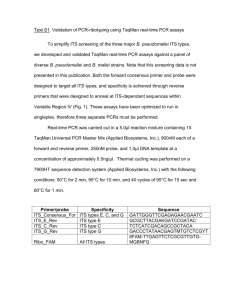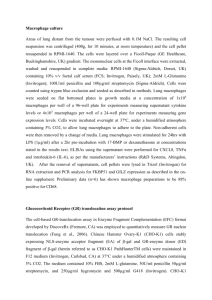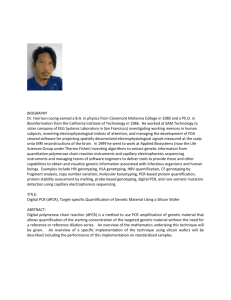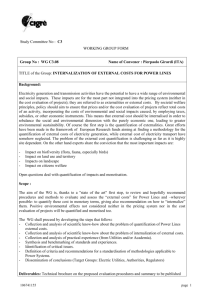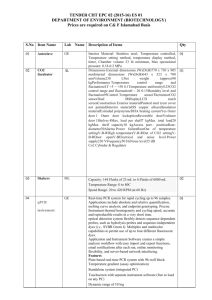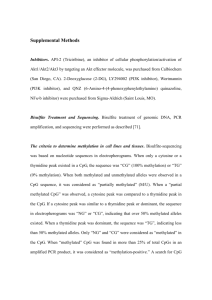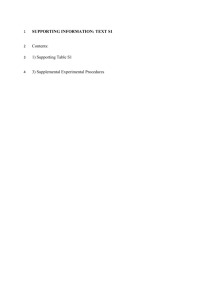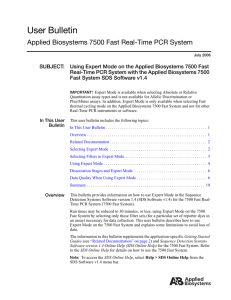HEP_24391_sm_suppinfo
advertisement
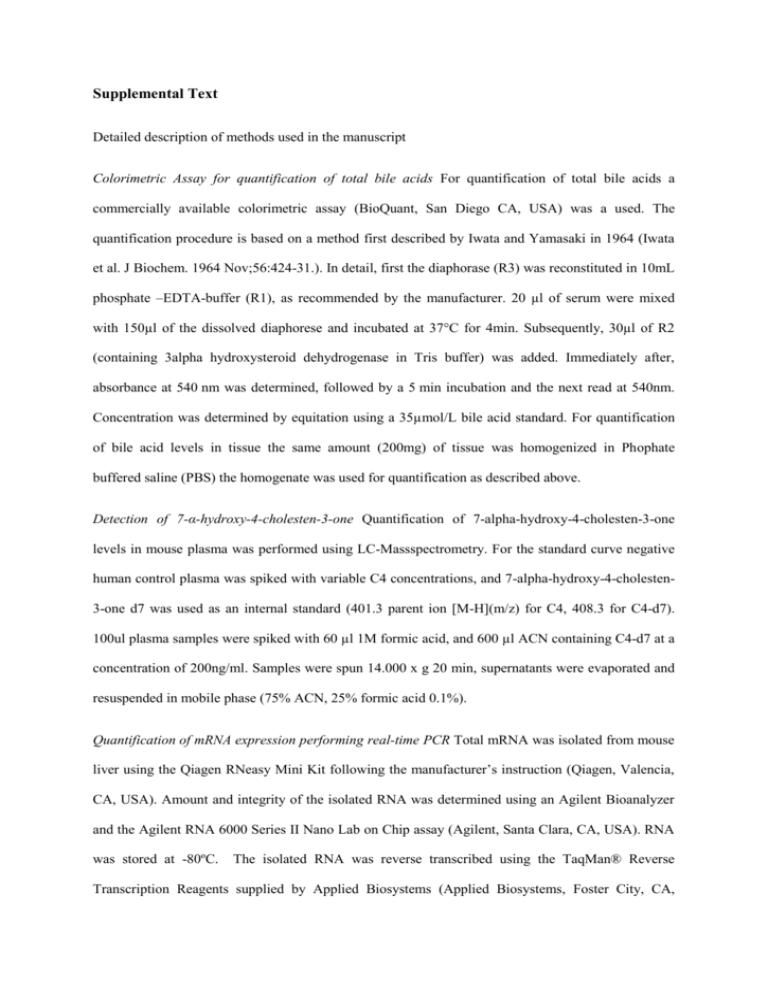
Supplemental Text Detailed description of methods used in the manuscript Colorimetric Assay for quantification of total bile acids For quantification of total bile acids a commercially available colorimetric assay (BioQuant, San Diego CA, USA) was a used. The quantification procedure is based on a method first described by Iwata and Yamasaki in 1964 (Iwata et al. J Biochem. 1964 Nov;56:424-31.). In detail, first the diaphorase (R3) was reconstituted in 10mL phosphate –EDTA-buffer (R1), as recommended by the manufacturer. 20 µl of serum were mixed with 150µl of the dissolved diaphorese and incubated at 37°C for 4min. Subsequently, 30µl of R2 (containing 3alpha hydroxysteroid dehydrogenase in Tris buffer) was added. Immediately after, absorbance at 540 nm was determined, followed by a 5 min incubation and the next read at 540nm. Concentration was determined by equitation using a 35µmol/L bile acid standard. For quantification of bile acid levels in tissue the same amount (200mg) of tissue was homogenized in Phophate buffered saline (PBS) the homogenate was used for quantification as described above. Detection of 7-α-hydroxy-4-cholesten-3-one Quantification of 7-alpha-hydroxy-4-cholesten-3-one levels in mouse plasma was performed using LC-Massspectrometry. For the standard curve negative human control plasma was spiked with variable C4 concentrations, and 7-alpha-hydroxy-4-cholesten3-one d7 was used as an internal standard (401.3 parent ion [M-H](m/z) for C4, 408.3 for C4-d7). 100ul plasma samples were spiked with 60 µl 1M formic acid, and 600 µl ACN containing C4-d7 at a concentration of 200ng/ml. Samples were spun 14.000 x g 20 min, supernatants were evaporated and resuspended in mobile phase (75% ACN, 25% formic acid 0.1%). Quantification of mRNA expression performing real-time PCR Total mRNA was isolated from mouse liver using the Qiagen RNeasy Mini Kit following the manufacturer’s instruction (Qiagen, Valencia, CA, USA). Amount and integrity of the isolated RNA was determined using an Agilent Bioanalyzer and the Agilent RNA 6000 Series II Nano Lab on Chip assay (Agilent, Santa Clara, CA, USA). RNA was stored at -80ºC. The isolated RNA was reverse transcribed using the TaqMan® Reverse Transcription Reagents supplied by Applied Biosystems (Applied Biosystems, Foster City, CA, USA). Briefly 2μg of total RNA were transcribed in a 50 μl reaction containing 1x TaqMan RTbuffer, 5.5 mM MgCl2, 500 μM dNTPs, 2.5 μM random hexamers, 0.4 U/μl RNase inhibitor 1.25U/μl Multiscribe Reverse Transcriptase. The reaction was performed under following cycler conditions 25ºC for 10 min, 48 ºC for 30min and 95ºC for 5min. The resulting cDNA was used for quantitative real-time PCR. TaqMan ® real-time PCR was performed in 20 µl reactions containing 20 ng cDNA, 1x Primer Probe Mix, 1x TaqMan gene expression Master Mix (Applied Biosystems). The PCR was performed under the recommended cycler conditions. The quantitative SYBRgreen PCR was carried out in 25 μl reaction volume containing 300 nM of each primer, 1 x SYBRgreen PCR Master Mix and 20 ng of the reverse transcribed cDNA. Fluorescence was detected using a ABI Prism 7700 sequence detection system (Applied Biosystems). The data were normalized to that of 18S and wiltype animals performing the Delta-Delta Ct method as previously described by Livak and Schmittgen, Methods. 2001;25(4):402-8. Immunohistochemistry Paraffin embedded tissue slides were deparaffinzed by incubation in two changes of xylol for 5 minutes. After rehydratization in a decreasing ethanol series (5 min incubation in each change), heat induced epitope retrieval (0.1 M citrate buffer pH 6.0) was performed for 10 min. Subsequently, the slides were washed several times in ice cold PBS and incubated for 1.5 h with 5%-FBS in PBS. Then the slides were incubated with the anti-Glut2- antibody clone ab54460 (Abcam, Cambridge, MA, USA), diluted 1:150. After several washing steps the immobilized primary antibodies were visualized using an anti-rabbit-horse radish peroxidase labeled secondary antibody and AEC-substrate (Vectorstain ABC-Kit, Vector Laboratories, Burlingame, CA, USA) following the manufacturer’s instructions. Mayer’s Heamtoxyllin was used for nucleic counterstaining (Sigma Aldrich). Pictures were taken using a Nikon Light microscope. For fluorescent staining a Alexafluor488 antibody was used and incubated as described above. The fluorescent nuclei counter staining was performed using DAPI containing mounting medium (Vector Laboratories). Calorimetric determination of hepatic glycogen. Hepatic glycogen content was determined as described previously 46. Frozen hepatic tissue was weighed and subsequently solved in 0.5 mL 30% KOH saturated with Na2SO4. After incubation at 99ºC for 30 min under vigorous shaking the homogenous solution was cooled on ice and 0.6 mL of 95% ethanol was added for precipitation of the glycogen. After 30 min incubation on ice the samples were centrifuged at 850 x g for 30 min and 4ºC. The supernatant was removed and the glycogen was solved in 1 mL water. Glycogen standards were prepared in water. A 0.1 mL aliquot of the glycogen solution was transferred to a new tube after that 0.1 mL of 5% phenol solution was added followed by addition of 1 mL of sulfuric acid. After 10 min incubation at room temperature the samples were incubated at 30ºC for additional 10 min. Subsequently 200 μL of the samples or standards were transferred to a 96-well plate, absorption was measured at 490nm using a spectrometric plate reader (Multiskan Spectrum, Thermo-Fisher, Waltham, MA). 5’Dionidase Type I – Luciferase Assay. A 750bp promoter fragment of the human 5’-Deiodinase Type I gene was subcloned into pGL3- basic (Promega, Madison, WI, USA) using the following primers: hDio1-(-720bp)-for 5’-ctggggagggctctgactacagaaatagtc-3’ and hDio1-(+30bp)-rev 5’- aagcttcagccctatctcggcaaagccag-3’ since this promoter fragment has been described to contain two TRE motifs 47. The coding sequence of the thyroid hormone receptor β (hTHRβ) was subcloned into pEF6-V5/His-TOPO® (Invitrogen) cagggcactggtaatttggctagaggac-3’ and using the hTHRβ-rev following primers: hTHRβ-for 5’- 5’-gcaatggaatgaaatgacacccagtagtgctg-3’. Subsequently, the resulting clones were sequence verified. OATP-mediated cellular entry of thyroid hormone was assessed monitoring the THRβ associated transactivation of a luciferase reporter containing the human Dio1-promoter. Briefly, HeLa cells were seeded in 24 well dishes and transfected with 0.5 μg of an OATP1B transporter including hOATP1B1, hOATP1B3, rOatp1b2, mOatp1b2 using Lipofectin® (invitrogen). After 48 hrs incubation the cells were transfected with 0.25μg of the hDio1-pGL3, 0.05 μg of Renilla and 0.5 of hTHRβ or a control vector using Lipofectin® (invitrogen). 16 hrs after transfection the cells were washed with serum free medium and incubated for 24 hrs with medium supplemented with 5% charcoal stripped FBS, containing 100 nM thyroxin or 100 nM triiodthyronine. The activity of luciferase was determined using the commercially available Luciferase Assay System® supplied by Promega following the manufacturer’s instructions.
